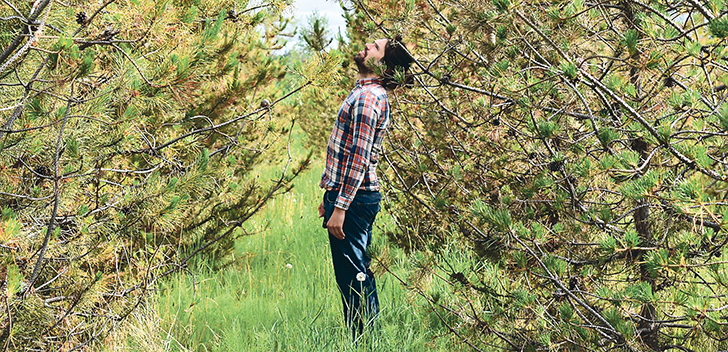The Carbon Farmer plants trees to sequester carbon and offset the environmental impact of ‘large smokestack type industries’
MANNING, Alta. — Products from the Carbon Farmer are less tangible than many farm commodities but they reach a burgeoning market.
The expected commodities from the certified organic grain farm are there, but so are thousands of trees planted on behalf of corporations for carbon credits and for non-regulated commercial needs to offset environmental impacts.
And there are many more trees planted and yet to plant in other regions of Alberta, Canada and internationally that serve the same purpose.
“We are selling carbon credits, we are selling grain and we are selling habitat restoration, and no different from any other product, we price it accordingly so we’re getting more than the cost of production,” said Brad Rabiey, who operates the business with his wife, Rebecca.
Read Also

Bio-fumigation may become new use for mustard
Mustard is great on hot dogs, but innovators in Western Canada have developed a new mustard variety for a different market — bio-fumigation.
“We are farmers first and foremost but what our products are, these days, are ever changing.”
He describes the Carbon Farmer as having three streams: vintage farmer, which supplies organic grains; forest farmer, which plants trees mostly for habitat restoration; and carbon farmer, which offsets the carbon footprints of commercial or individual clients.
The business will store carbon in the name of a commercial enterprise or corporation for as little as $15 per tonne.
Individuals can buy trees to offset their carbon footprint for as little as $1.99. Price varies by location and type of project.
“All the trees that we plant and sell on our site have been planted already,” said Rabiey. “It’s not a promise to plant you a tree in two years or five years or something like that and we’re going to disappear.”
The trees exist in the Carbon Farmer inventory and are available for purchase. In that way, buyers support the restoration of a forest.
Though the first forest was planted on the family farm near Manning, which comprises three quarter-sections of deeded land and another two that are rented, the business has also planted trees south of Calgary, other areas of Alberta and some in Ontario and plans the first planting in Saskatchewan this year near Smeaton.
“We only plant on conserved land that has to have some sort of legal caveat … because we don’t want obviously the trees to be chopped in the future,” Rabiey said.
Typically, that means planting on land protected under land trusts, conservation associations or municipal reserves and parks.
The business is profitable, he said, and about 98 percent of the revenue comes from corporate clients seeking to offset their carbon output.
“The business world has been more and more in tune with the environmental impact that they’re having and see it as something that they need to do from a corporate social responsibility perspective and we’ve been able to find a lot of partners over the years.
“Most of them reach out to us. We obviously do marketing and reaching out to them as well.”
Only tree species native to the area are planted, and different ages of trees are offered to ensure the project is long-lived and meets its mandate of long-term carbon sequestration.
Having the tree plantings spread across the province and country ensures a single fire won’t destroy the inventory.
“There’s a few reasons why we’ve had that corporate uptake,” said Rabiey.“Number one, we are planting trees here. There’s quite a few organizations that plant trees internationally but the fact that we’re literally in some of these corporations’ backyards, they can come and plant with us.
“They can see the projects. There’s a connection that way, there’s a transparency … that comes with actually being able to visit the projects.”
The Rabieys started the Carbon Farmer in 2007, when both were also working other jobs.
They started by planting 4,000 trees on the land once cleared by Brad’s grandparents.
“Literally planting trees where your grandparents had cleared them is a bit of a strange paradox, but at the end of the day, and I think Mom and Dad would agree at this point, is the value of the family farm is in the land and the stewardship of it and every generation I think is going to have a little bit of a different philosophy … of what is best for the land to make it sustainable for them.”
The young business got a boost in 2012 after an appearance on CBC’s Dragon’s Den, when investors Arlene Dickinson and Bruce Croxon paid $40,000 for 40 percent of the company.
“It was a game changer for us in terms of the credibility that we get,” he said. “The value from a mentorship perspective is definitely there.”
The two investors remain in-volved through board meetings and approval of annual business plans and large purchases.
Rabiey was working in the Alberta government’s energy ministry when climate change legislation was passed in 2005, which got him thinking about the social licence of the energy industry and the transition of his own third-generation family farm.
It’s a bit of irony that the Carbon Farmer, a business designed to address carbon sequestration, faces rising costs because of the NDP government’s carbon tax. It isn’t structured to help others manage the tax either.
“We pay carbon tax. We’re in the same boat as everyone else in that regard,” said Rabiey.
“We can’t play in that market. We can’t help you offset your carbon tax. The offsets that we provide are for what they call large final emitters. That means basically the large smokestack type industries.”
















